
Saltopus is a genus of very small bipedal dinosauriform containing the single species Saltopus elginensis from the late Triassic period of Scotland. It is one of the most famous Elgin Reptiles.

Staurikosaurus is a genus of herrerasaurid dinosaur from the Late Triassic of Brazil, found in the Santa Maria Formation.
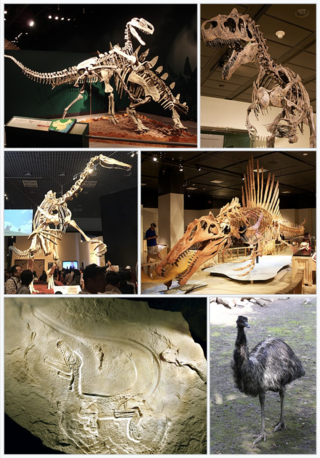
Tetanurae is a clade that includes most theropod dinosaurs, including megalosauroids, allosauroids, tyrannosauroids, ornithomimosaurs, compsognathids and maniraptorans. Tetanurans are defined as all theropods more closely related to modern birds than to Ceratosaurus and contain the majority of predatory dinosaur diversity. Tetanurae likely diverged from its sister group, Ceratosauria, during the late Triassic. Tetanurae first appeared in the fossil record by the Early Jurassic about 190 mya and by the Middle Jurassic had become globally distributed.
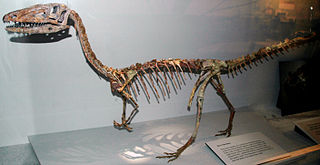
Coelophysoidea is an extinct clade of theropod dinosaurs common during the Late Triassic and Early Jurassic periods. They were widespread geographically, probably living on all continents. Coelophysoids were all slender, carnivorous forms with a superficial similarity to the coelurosaurs, with which they were formerly classified, and some species had delicate cranial crests. Sizes range from about 1 to 6 m in length. It is unknown what kind of external covering coelophysoids had, and various artists have portrayed them as either scaly or feathered. Some species may have lived in packs, as inferred from sites where numerous individuals have been found together.

Procompsognathus is an extinct genus of coelophysid theropod dinosaur that lived approximately 210 million years ago during the later part of the Triassic Period, in what is now Germany. Procompsognathus was a small-sized, lightly built, ground-dwelling, bipedal carnivore, that could grow up to 1 m (3.3 ft) long.

Liliensternus is an extinct genus of basal neotheropod dinosaur that lived approximately 210 million years ago during the latter part of the Triassic Period in what is now Germany. Liliensternus was a moderate-sized, bipedal, ground-dwelling carnivore, that could grow up to 5.15 m (16.9 ft) long. It is the best represented Triassic theropod from Europe and one of the largest known.
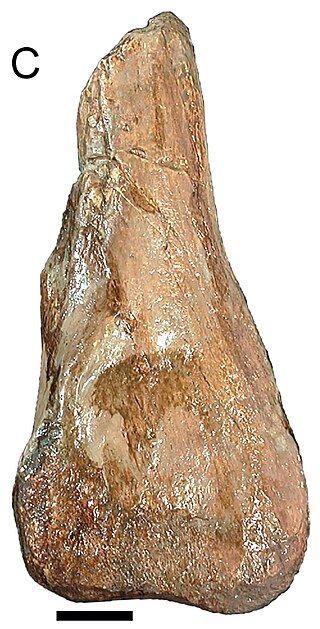
Ozraptor is a genus of possibly abelisauroid theropod dinosaur from the Middle Jurassic (Bajocian) Colalura Sandstone of Australia, known from fragmentary remains.

Gojirasaurus is a potentially dubious genus of coelophysoid theropod dinosaur named after the giant monster movie character Godzilla.

Alwalkeria is a genus partly based on basal saurischian dinosaur remains from the Late Triassic, living in India.
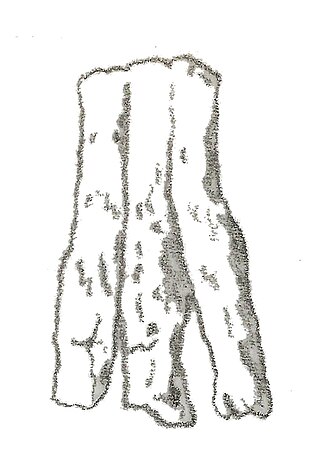
Avipes is a genus of extinct archosaurs represented by the single species Avipes dillstedtianus, which lived during the middle Triassic period. The only known fossil specimen, a partial foot (metatarsals), was found in Bedheim, Thuringia, Germany, in deposits of Lettenkohlensandstein. Avipes was named in 1932 by Huene. Although originally classified as a coelurosaur or a ceratosaur, a new study of the fossil specimen found that it was too incomplete to assign to a group more specific than Archosauria, and so it was regarded as indeterminate by Rauhut and Hungerbuhler in 2000.

Betasuchus is a genus of theropod dinosaur which lived during the Late Cretaceous Period. Betasuchus is, besides Orthomerus, the only dinosaur genus named from remains found in the Netherlands and the only non-avian theropod found in the Maastrichtian Beds.

Magnosaurus was a genus of theropod dinosaur from the Middle Jurassic of England. It is based on fragmentary remains and has often been confused with or included in Megalosaurus.
Halticosaurus (pron.:"HAL-tick-oh-SORE-us") is a dubious genus of theropod dinosaur from the late Triassic period. It is known from a single fragmentary fossil specimen of the species H. longotarsus, found in the Middle Stubensandstein formation of what is present-day Germany The only known specimen was poorly preserved and may have been put together from bones of unrelated animals. Further research would be required to determine which of the bones belonged together, and what kind of theropod Halticosaurus was. However, most of the bones have been lost. For these reasons, Halticosaurus is considered to be a nomen dubium.

Genyodectes is a genus of ceratosaurian theropod dinosaur from the Lower Cretaceous (Aptian) of South America. The holotype material was collected from the Cerro Barcino Formation, Cañadón Grande, Departamento Paso de Indios in the Chubut Province of Argentina and consists of an incomplete snout, including the premaxillae, portions of both maxillas, the right and left dentary, many teeth, a fragment of the left splenial, and parts of the supradentaries. These elements are generally poorly preserved and some are in articulation. The premaxilla of Genyodectes possesses relatively large and protruding teeth, similar to those of Ceratosaurus. The specific name, serus, means "late". In 2016 it was estimated to be 6.25 meters in length and 790 kg in weight.
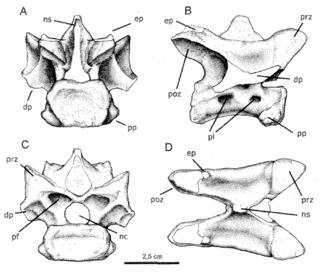
Laevisuchus is a genus of theropod dinosaur from the Late Cretaceous. Its remains were discovered by Charles Alfred Matley near Jabalpur in Maastrichtian "Carnosaur Bed" deposits in the Lameta Formation in Madhya Pradesh, central India, and were named and described by paleontologists Friedrich von Huene and Matley in 1933.
Orthogoniosaurus was a genus of theropod dinosaur from the late Maastrichtian-age Upper Cretaceous Lameta Formation of Jabalpur, India. It is based on one small, fragmentary tooth.
The Lissauer Breccia, sometimes referred to as the Kocury Locality, is a Norian geologic formation that is part of the larger Keuper limestone, which dominates across most of west and central Europe. Dinosaur remains diagnostic to the genus level are among the fossils that have been recovered from the formation. The site was studied in 1932 and was later forgotten and not explored until excavations began in 2012, and the Lissauer Breccia was re-described in 2021.

This timeline of coelophysoid research is a chronological listing of events in the history of paleontology focused on the coelophysoids, a group of primitive theropod dinosaurs that were among Earth's dominant predators during the Late Triassic and Early Jurassic epochs. Although formally trained scientists didn't discover coelophysoid fossils until the late 19th century, Native Americans of the modern southwestern United States may have already encountered their fossils. Navajo creation mythology describes the early Earth as being inhabited by a variety of different kinds of monsters who hunted humans for food. These monsters were killed by storms and the heroic Monster Slayers, leaving behind their bones. As these tales were told in New Mexico not far from bonebeds of Coelophysis, this dinosaur's remains may have been among the fossil remains that inspired the story.

This timeline of ceratosaur research is a chronological listing of events in the history of paleontology focused on the ceratosaurs, a group of relatively primitive, often horned, predatory theropod dinosaurs that became the apex predators of the southern hemisphere during the Late Cretaceous. The nature and taxonomic composition of the Ceratosauria has been controversial since the group was first distinguished in the late 19th century. In 1884 Othniel Charles Marsh described the new genus and species Ceratosaurus nasicornis from the Late Jurassic Morrison Formation of the western United States. He felt that it belonged in a new family that he called the Ceratosauridae. He created the new taxon Ceratosauria to include both the Ceratosauridae and the ostrich-like ornithomimids. The idea of the Ceratosauria was soon contested, however. Later that same decade both Lydekker and Marsh's hated rival Edward Drinker Cope argued that the taxon was invalid.
Kocurypelta is an extinct genus of paratypothoracin aetosaur from the Late Triassic (Norian)-aged Lissauer Breccia of southern Poland. Only the type species is known, which is K. silvestris, described by Czepiński et al. in 2021.































